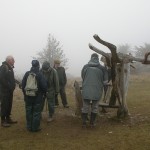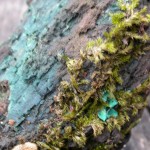The temperature was a chilly 3C and the mist was dense when Chris Ash led a walk around the northern part of Aston Rowant National Nature Reserve on Wednesday 20th March. The walk started out along the Talking Trail, with wooden sculptures and enclosed audio recordings illustrating various aspects of the wildlife and history of the reserve. First stop was a set of carved posts representing bats echo-locating moths. Further on, a sculpture next to an old chalk pit was a reminder of the human history of the site. Another represented a Hare’s ear. The track opened up onto chalk grassland, with enormous numbers of anthills made by Yellow Meadow Ants. The delicate sculpture of a Red Kite marked the location of the view to the north-west, which we were assured would have been the best view from the reserve if the visibility had been greater than a few hundred metres.
The walk continued into the woodland on the steep north side of the reserve. A few big Juniper bushes were growing beside the track. The next Talking Trail sculptures were a Ring Ouzel installation and a delicate structure representing a home for a Dormouse. The route then turned steeply downwards through the woods. A former quarry site had the characteristic track-way for the extraction of material leading out of it. Looking back up the slope, lines of ridges and dips contouring round the hillside perhaps indicated the traces of former ploughing and terracing. An unfamiliar tree with black leaf buds and tufted flower buds was identified as a Wych Elm. Silvery leaves on the ground betrayed the location of Whitebeam trees. A number of pieces of fallen wood were stained bright blue-green by the Green Elfcup fungus. At the bottom of the hillside, Chris pointed out a steep valley from which a thicket of ash had recently been cleared. It was hoped that this would give a scrub layer a chance to develop and provide more suitable habitat for the woodland birds. The route then returned back up a sunken track-way. A steep diversion to the side of the track revealed the site of a former saw pit. At the top of the hill, there was an area with Male Ferns, perhaps indicating a pocket of damper clay. In the same area was a magnificent circle of big cherry trees, probably originating long ago from a single tree. The walk was followed by lunch at the Carriers Arms near Watlington.


